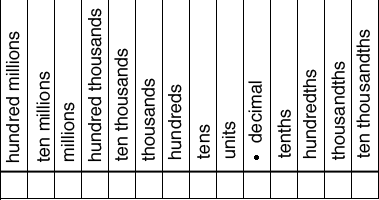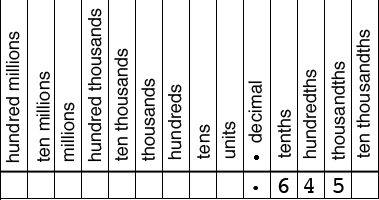| |||
| Math Central | Quandaries & Queries |
|
Question from Ruth: what does the 0 represent in .018 versus the decimal .180? As in, changing these to fractions? Thank you. |
Hi Ruth,
The 0 in the two decimal representations of the numbers have different place values. Below is a place value chart.

Below I have written the decimal number 0.645 in the place value chart.

Since 6 is in the tenths place it represents $\large \frac{6}{10}.$
Since 4 is in the hundredths place it represents $\large \frac{4}{100}.$
Since 5 is in the thousandths place it represents $\large \frac{5}{1000}.$
Thus
\[0.645 = \frac{6}{10} + \frac{4}{100} + \frac{5}{1000}.\]
Writing this with a common denominator I get
\[0.645 = \frac{6 + 40 + 500}{1000} = \frac{645}{1000}.\]
This fraction can be simplified.
In a similar fashion
\[0.108 = \frac{1 + 0 + 800}{1000} = \frac{108}{1000}.\]
This fraction can also be simplified.
I hope this helps,
Penny
 |
||
| * Registered trade mark of Imperial Oil Limited. Used under license. | ||
Math Central is supported by the University of Regina and the Imperial Oil Foundation.